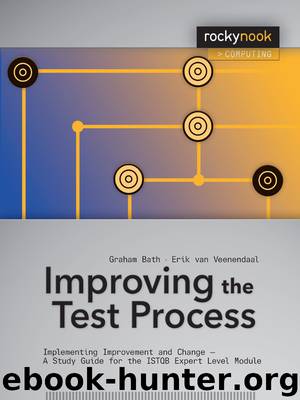Improving the Test Process by Graham Bath · Erik van Veenendaal

Author:Graham Bath · Erik van Veenendaal
Language: eng
Format: epub
Publisher: Gerhard Rossbach
Published: 2014-03-14T16:00:00+00:00
5.5 Mixed Approaches
Most widely used test improvement models are used with a top-down approach. However, it is also recommended to apply bottom-up, analytical-based approaches. Top-down approaches have proven to be valuable in establishing improvements. They provide the means to set up a solid test engineering working environment and to establish product quality targets. Experiences in practice have shown significant benefits of this approach. However, organizations also need to apply a bottom-up approach, such as causal analysis of day-to-day problems and the gathering and analysis of process and product metrics. By setting up a measurement-based approach in their organizations, testing will become better understood. Remember, knowledge is an important basis for improvement. The models can be used to define the strategic vision for the next year(s) and provide long-term improvement goals. Bottom-up analytical approaches may well be used to identify some critical issues that need to be solved today rather than tomorrow and thus provide short-term improvement goals.
In practice, we almost never find just a model-based, content-based, or analytical approach being applied in isolation. It may be the case that one of these approaches is leading, but it will most likely be blended with another one. Therefore, in practice, we often have a mixed approach, even if a process model approach is chosen. Here are a couple of examples of mixed approaches, such as the use of analytical approaches within a process model or content model:
Usage of causal analysis during a TMMi test improvement program
Usage of metrics during a STEP test improvement program
More and detailed examples of this are provided in the next section.
Download
This site does not store any files on its server. We only index and link to content provided by other sites. Please contact the content providers to delete copyright contents if any and email us, we'll remove relevant links or contents immediately.
| Coding Theory | Localization |
| Logic | Object-Oriented Design |
| Performance Optimization | Quality Control |
| Reengineering | Robohelp |
| Software Development | Software Reuse |
| Structured Design | Testing |
| Tools | UML |
The Mikado Method by Ola Ellnestam Daniel Brolund(20604)
Hello! Python by Anthony Briggs(19900)
Secrets of the JavaScript Ninja by John Resig Bear Bibeault(18208)
Dependency Injection in .NET by Mark Seemann(18109)
The Well-Grounded Java Developer by Benjamin J. Evans Martijn Verburg(17576)
OCA Java SE 8 Programmer I Certification Guide by Mala Gupta(17422)
Kotlin in Action by Dmitry Jemerov(17185)
Adobe Camera Raw For Digital Photographers Only by Rob Sheppard(16934)
Algorithms of the Intelligent Web by Haralambos Marmanis;Dmitry Babenko(16237)
Grails in Action by Glen Smith Peter Ledbrook(15390)
Test-Driven iOS Development with Swift 4 by Dominik Hauser(10394)
Becoming a Dynamics 365 Finance and Supply Chain Solution Architect by Brent Dawson(8056)
Microservices with Go by Alexander Shuiskov(7820)
Practical Design Patterns for Java Developers by Miroslav Wengner(7721)
Test Automation Engineering Handbook by Manikandan Sambamurthy(7672)
Angular Projects - Third Edition by Aristeidis Bampakos(7160)
The Art of Crafting User Stories by The Art of Crafting User Stories(6611)
NetSuite for Consultants - Second Edition by Peter Ries(6533)
Demystifying Cryptography with OpenSSL 3.0 by Alexei Khlebnikov(6305)
